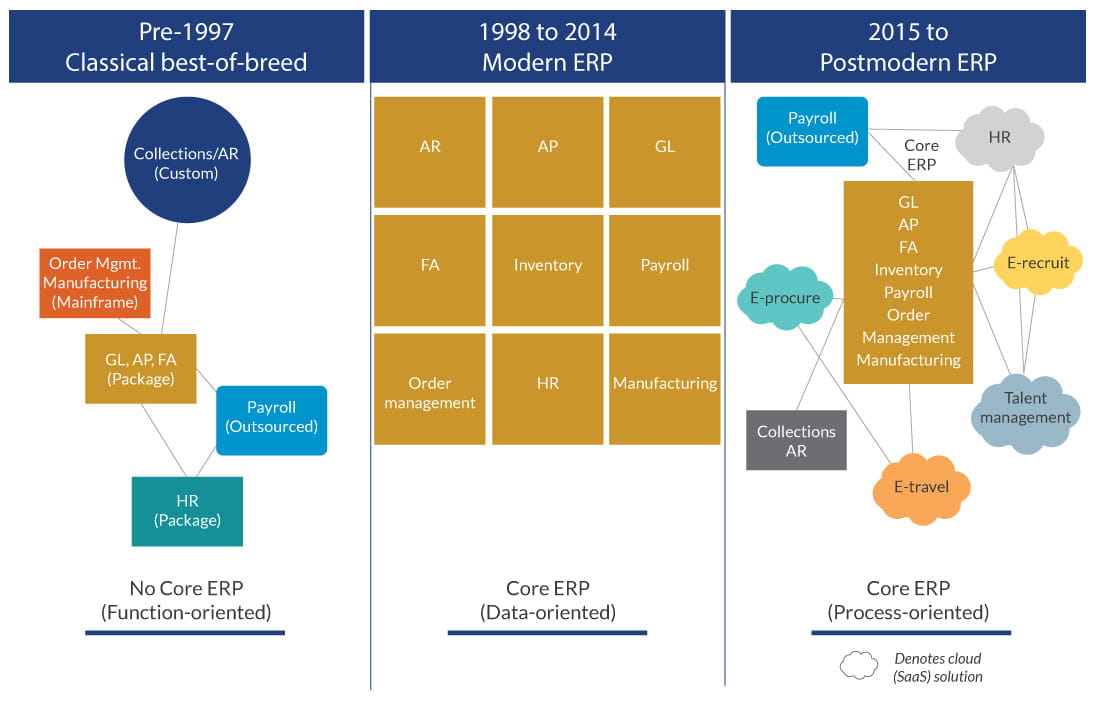Data is big business — and for good reason. Real-time, reliable, enterprisewide data can help businesses make better decisions about everything from managing inventory to launching new products in new markets. But even though your systems may be overflowing with data, leaders often wonder if they can trust the information or turn it into insights that matter. So, how do you make your data work for you, instead of the other way around?
In our work with middle-market clients, we’ve seen organizations struggle with outdated legacy systems, piecemeal add-ons, and conflicting “sources of truth” that waste time and resources. Teams spend more time playing whack-a-mole, patching problems with a messy stack of software and services, instead of building a sustainable data foundation. And as AI fuels unprecedented change for organizations across industries, many are revisiting foundational data considerations — because at one time, clean, reliable data was “only” key to business success; generative AI now makes it nonnegotiable. The greatest missing link is usually data architecture.
Before data-driven decision-making and AI deliver real value, you need to know exactly how your data flows through your systems. A clear blueprint helps you manage that data flow, govern it, and use it well. The right architecture ties it all together — software selection, governance, performance management, and business intelligence — giving you an advantage in a competitive market.
Five advantages of the right data architecture
Each organization has its own systems, processes, and goals that impact how data is managed. There’s no one-size-fits-all approach to data architecture, but there are common best practices and benefits.
1. Own — and trust — your data
Good data architecture taps into the power of data governance and data management to create a common language that stands the test of time. In many organizations, departments and systems are siloed, and each team uses its own technology populated with its own data language. For example, different job titles used by HR and operations can create different versions of the same “objective” company data, creating confusion and gridlock.
Good data governance applies metadata modeling and data dictionaries to impose a common language and set of agreed-upon rules across an enterprise. In doing so, it creates a “single source of truth” that gives everyone an accurate, holistic view of organizational performance. This standardized data forms the foundation of better insights and smarter decision-making —especially for AI agents where hallucinations and bad data can lead to greater consequences. Data management protects well-governed data by creating a repository where it can live safely forever. You’ll own it, regardless of how your source applications or reporting evolves. Even if new performance management technologies and BI requirements are introduced, a sound data architecture foundation will persist.
2. Take advantage of new point solutions without disrupting your organization
Techniques and digital tools to capture source data are evolving constantly. Even ERPs — once considered a silver bullet — can’t do it all; in the past eight years, we’ve seen a flood of data solutions designed around specific business processes. Compounding the challenge, each category (data governance, data management, performance management, business intelligence, etc.) has its own slew of specialty vendors with wildly different capabilities, and industry-specific nuances bring even more point players into the mix. Navigating the current market is like comparing apples, oranges, and grapefruits.

1 Infographic 1: Gartner's ERP timeline (2022)
The good news? The right data governance and management, including a sound metadata model and data repository, position your business to handle tech changes with minimal disruption. Departments can take advantage of new point solutions that help them work smarter and faster; and rather than “going rogue,” those new solutions can be put into your existing data architecture. Lengthy rework is avoided, freeing the business to use the saved time, expense, and resource allocation elsewhere.
And not only are tools and techniques evolving, but the very way we think about tech utility, application, and integration for business is poised to change fundamentally. Consider agentic AI, which is expected to usher in a new era of ERP and software as a service (SaaS) business models. Instead of business logic being built in multiple applications and databases, agentic AI can be deployed to coordinate business processes across technologies. And for agentic AI to be deployed successfully, a data architecture is essential.
3. Use lagging and leading indicators to adjust your operations
Data architecture is the key to unlocking the power of actionable analytics. You need both backward- and forward-looking data to understand where they’ve been and to make decisions that drive better outcomes. For example, when a profitable job site ends up losing money because of a single safety incident, the data only tells you what’s already happened — it’s a lagging indicator. Routine on-site safety talks, on the other hand, are an actionable leading indicator: data aggregated across the enterprise tells you these five-minute huddles help predict future behavior and reduce future accidents.
4. Use data to drive your business strategy
Companies don’t invest in data just to sit on it. Well-architected, cleansed data enables trustworthy information, actionable insights, smarter decisions, and better outcomes. Organizations can more accurately forecast sales, manage inventory, better leverage AI and emerging technologies, gauge employee performance, run what-if analyses, and more. For example, if your business plan is focused on driving growth, you might choose to capture insights on your highest-performing products in terms of sales growth and market penetration. If it’s critical that you minimize risk, you might opt to focus on enterprise data that reflects your quality assurance, compliance, and safety progress. Data architecture is the foundation that lets you gain control of your data and put it to work for your business.
5. Prepare for an ever-changing future
“Agility” is today’s buzzword, but few organizations are prepared to pivot quickly as business and technology change. Data architecture equips you to make well-informed business decisions with speed and confidence — at both the strategic and front-line levels. It also lets you take advantage of new technologies as they emerge — and implement them faster than competitors who are struggling with tech disruption and system integration. While they’re scrambling to catch up, you’re already focused on what’s next.
And when it comes to AI, we believe it can accelerate business and create value, but concerns about risk hold many back from adopting it. This is yet another area where data architecture is crucial. Good data architecture helps you govern and manage your data, which, in turn, instills trust in the insights you draw from it, and the technology that uses it. Investing in your architecture shows that you’re anticipating and mitigating risk — driving innovation and helping to get your team on board along the way.
The bottom line
The right data architecture can help you create competitive advantage, decrease costs, and increase operational capacity. Whether you want to minimize risk, penetrate new markets, sell more of the same product, or increase profitability, it’s ultimately data that will deliver the insights you need to achieve your goal.





